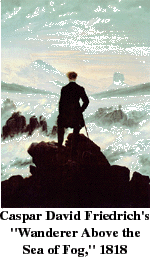 We spent
a good deal of class time today delineating the characteristics of the Romantic
hero, as I read excerpts from Lord Byron's Childe Harold's Pilgrimage:
We spent
a good deal of class time today delineating the characteristics of the Romantic
hero, as I read excerpts from Lord Byron's Childe Harold's Pilgrimage:
1) We find in this figure a certain ambiguity in character; the Romantic
hero can even approach a Satanic stature in his (almost always his)
search for transcendence. By the same token, we are supposed to admire the
courageousness of the Romantic hero, who, unlike others, is unafraid to
explore even the darkest emotions and natural powers.
2) An emphasis on introspection (including an exploration of the darker
side of the mind), as Aaron Hause pointed out, leading to what Harold Bloom
has termed the "internalization of the quest romance." (One does
not quest in the material world but in the world of the mind. I also pointed
out that this internalization is yet another manifestation of the movement
from a shame culture into a guilt culture.) Indeed, the Romantic hero goes
so far as to believe that the "mind is its own place, and in itself/
Can make a Heav'n of Hell, a Hell of Heav'n," as Aisha Peay explained,
quoting Milton's Paradise Lost. Instead of the external battles of
old, Lane Sanders explained, one is given an internal battle or psychomachia.
Lane added that one is consequently able to create exclusively through one's
own mind. There is no need, then, for God, nature or even women to ensure
creation.
3) Importance is placed on the individual (over society), as Beth Dick suggested.
4) The Romantic hero is concerned with ideals rather than convention, Lilly
Ewing added. These characters flout all conventions and laws in their search
for something beyond the everyday, the ordinary.
5) a tendency to suffer; after all, the search for transcendence is, almost
by necessity, doomed to failure, Beth Dick pointed out. These figures are
searching for something that is beyond the everyday world, something that
therefore cannot be had in the world. As a result, they are often undone
by the world of material objects and by the limitations of the flesh. One
result of this impossible quest or drive is that it uses up the physical
body; the search can often be fatal.
6) The Romantic hero puts everything on the line in search of intensity
of feeling, which sometimes puts the Romantic hero on the brink of madness,
Luke Jacoby suggested.
7) The Romantic hero values (self-)knowledge over brute strength, which
helps to distinguish this figure from the epic heroes of old.
8) D. J. Dangler explained that the Romantic hero's quest for extremes of
emotion is coupled with a search for the extreme landscapes of nature, i.e.
the sublime.
For these reasons, the Romantics admired Milton's Satan, who seemed an example of a character that refuses to submit his own freedom to anyone else's rules or conventions. For this reason, as Melissa Young-Spillers illustrated during her presentation earlier in the semester, Satan is often represented by Romantic artists in sublime landscapes that would normally be the clime of Romantic heroes. (For one example, click here.) These observations led to a number of questions: To what extent can we consider Walton and Frankenstein as Romantic heroes? To what extent can we see Homer's Odyssey behind Mary Shelley's text? Who precisely is the hero in this tale? Although Victor Frankenstein is the likely candidate for hero, one can argue that Mary Shelley is also using this character as the means to critique the concept of the Romantic or epic hero. In some ways, even the monster could be seen as a perversion of an epic hero, given his greater than human abilities and stature. Walton and Victor also both go on epic quests, like Odysseus, but one cannot help but question the ambition of these two characters, an ambition that almost leads to the death of Walton's crew and that does lead to the death of Victor's family. Victor's scientific quest was also aligned with the Romantic desire to go beyond the veil between life and death; in Victor's case, one could say that that desire is literalized.
Prometheus is another figure that gets picked up by the Romantic poets as an example of a proto-Romantic-hero. I read out sections of Lord Byron's poem, "Prometheus," as an example. We then discussed why Mary Shelley might have subtitled her novel "The Modern Prometheus." Recalling Mary Shelley's description of the conception of her story in the company of Byron and Percy Shelley (pp. 360-66), we began exploring to what extent Mary Shelley might be including in her novel an inherent critique of the values associated with Prometheus. We were aided by the original myth in Hesiod. This passage helped us realize that the myth is intimately tied also to the creation of woman. In the original story, woman is represented as a punishment for mankind because of Prometheus' theft of fire from Zeus. We could, then, see Victor as a sort of Prometheus figure (stealing the fire of life from the gods in order to give it to mankind) but a Prometheus figure that is only ambiguously heroic. We can also begin to ask ourselves to what extent the monster could be said to represent womankind, who in the Hesiod myth is clearly associated with the monstrous. Mary Shelley now recasts the myth, Meg Lowry explained. In her story, it is now man that created evil and the result is the death of innocent women. The values Mary Shelley seems to value instead include marriage, family, and one's responsibilities to others. By making Victor a more ambiguously heroic character, she may be wondering whether a Romantic hero is too dangerous a figure to hold up as model.
 BACK TO COURSE SYLLABUS
BACK TO COURSE SYLLABUS